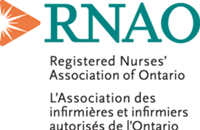RNAO welcomes doubling of nurse practitioners, and warns that the inadequate growth in RNs compromises Ontarians' health
TORONTO, Jan. 30, 2012 /CNW/ - A report on the country's nursing workforce reveals a disturbing trend that governments must address to ensure patients who are in hospitals, home care and long-term care receive the care they need and deserve says the Registered Nurses' Association of Ontario (RNAO).
Figures compiled by the Canadian Institute of Health Information (CIHI) indicate the registered nurse (RN) workforce rose by less than two per cent per year between 2006 and 2010. "This is bad news for Canadians," says David McNeil, President of RNAO, adding that "there is conclusive evidence that a higher proportion of RNs is associated with lower mortality and better patient outcomes."
McNeil says the CIHI numbers reinforce what members of the association have been saying for the past few years; that RNs are being replaced by other care providers. RNAO's president adds that "if governments want to see greater system performance, they must ensure there are adequate numbers of RNs not just in hospital settings but across the system as well."
The CIHI report also shows that Ontario continues to lag behind other provinces with the second lowest number of registered nurses relative to population. Ontario has 721 RNs per 100,000 while the national average is 787 per 100,000.
"At a time when the Ontario government's agenda is centred on excellent care for all, it's critical that attention be focused on increasing the supply and employment of RNs," says McNeil, adding that not doing so will seriously compromise patients' health outcomes and system performance.
The one bright spot in the report says Doris Grinspun, RNAO's Executive Director, is the number of nurse practitioners, which doubled from 1,129 in 2006 to 2,486 in 2010. Ontario has the greatest share of NPs working in the health-care system.
Nurse practitioners are registered nurses with additional education and legislative authority to diagnose and treat common illnesses and injuries, prescribe medications, and order diagnostic tests such as x-rays and ultrasounds. In Ontario, new powers to prescribe all medications (with the exception of narcotics) and the ability to admit and discharge patients from hospitals have made their role even more valuable.
"NPs are addressing many of the challenges facing our health-care system. They are improving access to care and reducing wait times. Their increased numbers are also proof that governments and employers see them as an effective way to positively transform our health-care system," says Grinspun, adding the next step is realizing the untapped potential RNs can bring to the system by expanding their scope of practice. "The more we can do to better help patients improve their health in a timely manner, the less frustration they will experience and the better their health outcomes will be," says Grinspun.
The Registered Nurses' Association of Ontario (RNAO) is the professional association representing registered nurses in Ontario. Since 1925, RNAO has advocated for healthy public policy, promoted excellence in nursing practice, increased nurses' contribution to shaping the health-care system, and influenced decisions that affect nurses and the public they serve.
For more information about RNAO, including the association's report, visit our website at www.rnao.org. You can also check out our Facebook page at www.rnao.org/facebook and follow us on Twitter at www.twitter.com/rnao.
To arrange an interview, please contact:
Marion Zych
Director of Communications
Registered Nurses' Association of Ontario (RNAO)
158 Pearl Street
Toronto, ON
647-406-5605 (cellular)
416-408-5605 (office)

Share this article